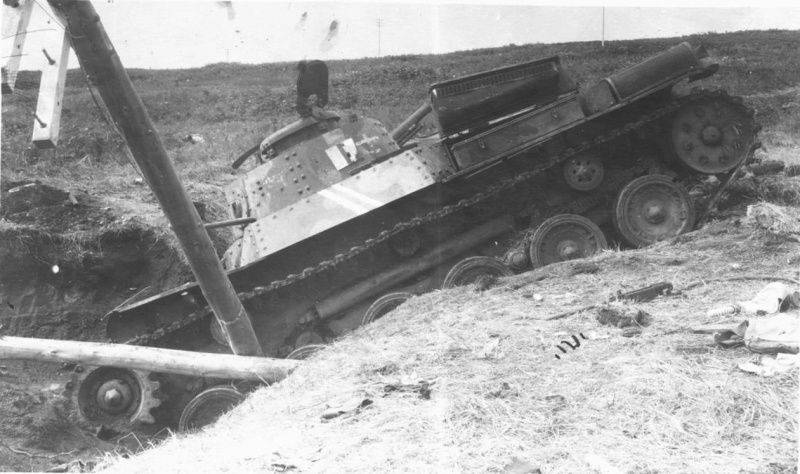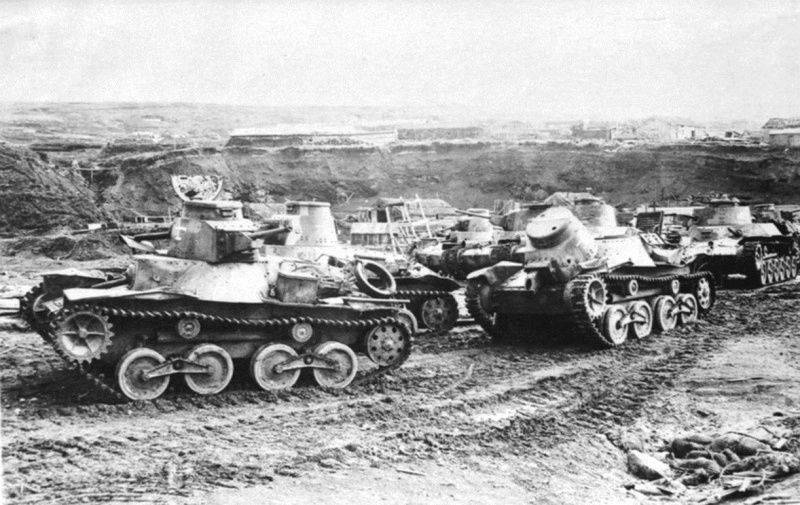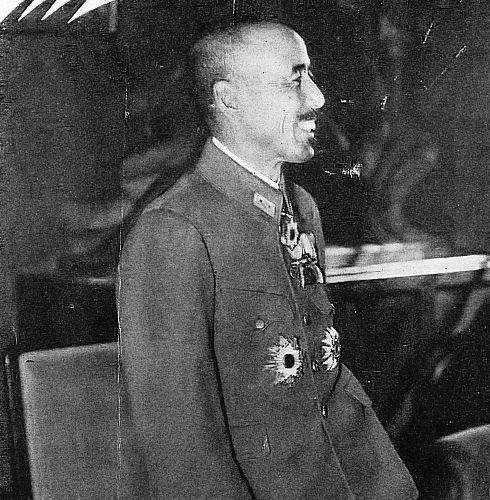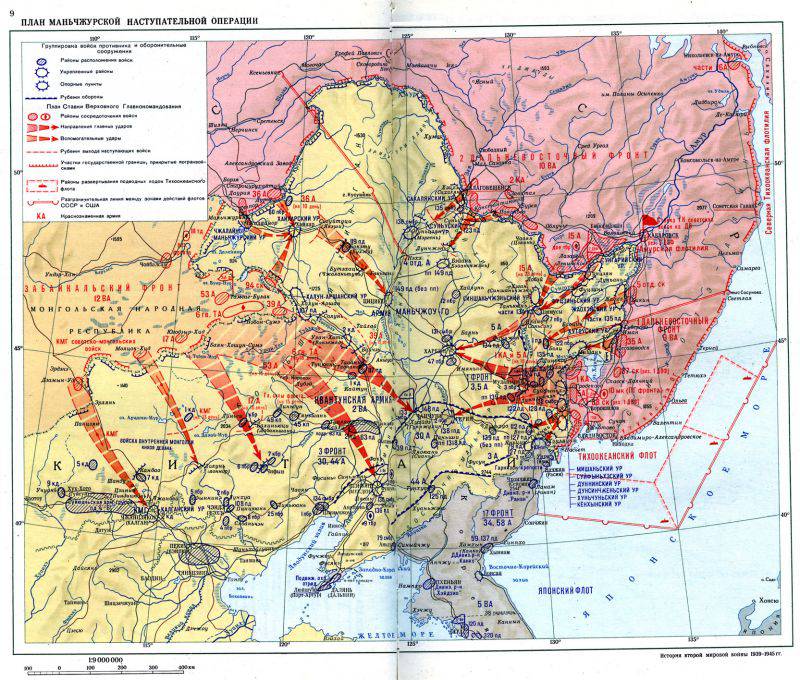The combat potential of the Kwantung Army
Fighting during the war of the USSR with Japan were conducted mainly in the territory of Northeast China (Manchuria), which the Japanese seized since 1931. Here they created the puppet state of Manchukuo headed by Emperor Pu I. But the regime of Emperor Manchukuo “reigned but did not rule”, the Japanese disposed of everything in Manchuria, turning this region into an integral part of the Japanese empire, its second industrial base and strategic military bridgehead for further seizures in China and the advance to the north. Manchuria was to become a strategic base for invading Primorye and other areas of the Soviet Far East.
In Manchuria and in Korea, large military-industrial centers were created. Metallurgical aviation, weapons, powder and other enterprises significantly strengthened the military potential of the Japanese Empire. Their production value is constantly growing. Thus, the production of steel in ingots increased from 573 thousand tons in 1941 to 1,3 million tons in 1944, and smelting of pig iron during the same period - from 1,4 million tons to 2,5 million tons; Coal mining increased from 16 million tons in 1938 to 25,6 million tons in 1944. A powerful energy base was created in Manchuria and Korea. In 1944, the production capacity of power plants amounted to more than 10 million kilowatts, that is, almost as much as in Japan itself. In Manchuria and Korea, 60% of the synthetic fuel production capacity was located. At a time when US-British forces blocked the supply of oil and oil products and other resources from the South Sea region, these territories became the second main military-industrial base for the Japanese Empire, which allowed the war to continue.
During the period of Japanese domination in Manchuria, the network of communications that were of primary military importance was greatly expanded here. If in 1931, the length of railways in Manchuria was only 6140 kilometers, and there were almost no roads, by 1945, about 13700 kilometers of railways and 22 thousands of roads were built. The number of airfields, air bases, landing sites increased from 5 in 1931 to 416 in 1945. If before the Japanese occupation in Manchuria there were only 7 military warehouses, then 1945 became their 870. Sharply increased the number of barracks, facilities for basing troops. In 1931, the barracks could accommodate 7,5 divisions, that is, about 100 thousand people. In 1945, their capacity was increased to 55 divisions, and when compacting they could accommodate 72 divisions, that is, it was possible to deploy 1,5 million army.
A similar picture was in North Korea, where, along with the growth in the number of troops, the network of railways and highways, airfields, and barracks, the naval infrastructure was rapidly developed. If in the 1931 year, Yuki, Racin (Nachzhin), Seisin (Chongjin) were fishing ports of local importance, in 1945 they were naval bases where ships and equipment could be based.
Since 1934, the Japanese have been active in the construction of fortified areas. In Northeast China, seven fortified areas were erected from 1934 to 1937, which covered the border for 150 km. These areas had 300 long-term fortifications. By 1945, the Japanese had already had 17 fortified areas in China with more than 4500 long-term structures. They covered about 800 km. In Korea, a 4 fortified area was built.
The construction of military infrastructure was carried out on the border of the USSR or in its immediate vicinity, which fully met the aggressive designs of the Japanese military-political leadership. The Japanese deliberately created a strategic base for attacking the USSR. Fortified areas were necessary for the concentration and deployment of troops, and were to be the starting areas for an attack on major operational lines. In the west, Kalgansky, Halun-Arshansky, Zhalainor-Manchu and Khailar fortified areas were built; in the north: Sakhalyan, Sunu, Xinshan, Sungari and Fujin fortified areas.
The eastern border of Manchuria, on the border with the Soviet Primorye, was best prepared in engineering terms. Here, at a distance of about 600 km from the city of Raohe in the north to the city of Kinei in the south, 8 fortified areas were located at once: Raohei, Hutou, Mishansky, Suifnhe (Pogranichnensky), Dunninsky, Dunshinshensky, Hunchunsky and Kyonhyunsky. Each fortified area consisted of 3-7 resistance nodes and support points, had 50-100 km along the front and 50 km in depth. The centers of resistance and strong points had long-term constructions, were placed on the dominant heights and the most important directions. They adjoined each other and had a fire connection. For example. In the Pogranichnenskiy fortified area, the length of which along the front was about 60 km, there were 122 dota, 131 bunker, over 26 kilometers of anti-tank ditches, ridges and escarpes, 14 kilometers of wire obstacles, more than 20 kilometers of trenches and communication routes. The defenses were echeloned to the depth of 30 km and had two lanes. The first lane was the depth of 3-7 km, the second - to 5 km. In the fortifications, the Japanese installed guns in caliber from 75 to 430 mm.
Kwantung Army
By the beginning of the war with the USSR, the Kwantung army under the leadership of Otozo Yamada and the local forces supporting it were significant in composition. Their total number reached 881 thousand people. The Kwantung Army included three fronts - the 1st, 3rd (in Northeast China) and the 17th (in North Korea) and one (4th) separate army, the 2nd and 5th air armies , Sungarian military river flotilla.
The 1st front included the 3rd and 5th armies (10 infantry divisions and 1 infantry brigade) and covered the eastern strategic flank on the border with Soviet Primorye. The main forces of the front were located in the Mudanjiang direction. The 3rd front included the 30th and 44th armies (8 infantry divisions, 3 infantry and 1 tank brigades). The main forces of the front were stationed in the center of Northeast China, in the Mukden (Shenyang) region - Changchun. Part of the front troops was located on the border with Mongolia. The 4th separate army (3 infantry divisions and 4 infantry brigades) was deployed in the north-west of Manchuria. The 17th front, which was introduced into the Kwantung Army with the outbreak of war, included the 34th and 59th armies (9 infantry divisions). The troops of the 17th front were located in Korea. In the reserve of the commander of the Kwantung Army there was one infantry division and 1 infantry brigade. The Sungarian military river flotilla had 4 gunboats, 12 armored boats, 10 patrol boats, 3 marine regiments with 50 landing motorized boats and 60 landing motor boats. In total, the Kwantung Army numbered 31 infantry divisions, 9 infantry brigades, 2 tank brigades, and 2 aviation armies. At the beginning of hostilities, it numbered more than 440 thousand people, 1155 tanks and self-propelled guns, up to 1800 aircraft.
In addition, the local command was subordinated to the Japanese command: the Manzhou-Guo Army (2 infantry divisions and the refinery divisions, 2 infantry brigade divisions, individual cavalry regiment units), the Mengjiang (Inner Mongolia) army under the command of Prince Deavans, and the Ottoman divisions of the Ottoman division of the divisions of the Mengjiang (Inner Mongolia) under the command of Prince Devan. separate cavalry brigades and 12 special regiment) and Suiyuan army group (up to 4 infantry divisions). In addition, in the territory of Manzhou-Guo there were 2 military districts that had their own separate units and formations. The troops of the 4 Front (3 Infantry Divisions and 1 Tank Regiment) were based on Sakhalin and Kuriles.
Thus, at the beginning of the war, Japan in the Far East could oppose the Soviet troops 40-42 infantry, 7 cavalry divisions, 22 infantry brigades. 2 tank brigades and several separate regiments and units. In total, the Kwantung Army and puppet troops numbered about 900 thousand - 1 million people.
Puppet troops had a small combat capability. The infantry divisions of the Kwantung Army were different both in organization and in size. Most divisions consisted of three infantry regiments, some from two infantry brigades. The number of divisions ranged from 10 to 17 thousand people. In service with the Japanese infantry were rifles, machine guns, guns, mortars in some parts - light tanks, armored vehicles. Infantry brigades totaled up to 7 thousand people. In many divisions and brigades were formed so-called. “Raid troops” or suicide squads. They were mobile and had to conduct reconnaissance and attack the enemy’s mechanized columns. In the units of the Kwantung Army, there were almost no automatic weapons, anti-tank guns, rocket artillery, there was little artillery of the Russian State Control Committee and large-caliber artillery - in the infantry division and brigades of artillery regiments and battalions were mainly 75-mm guns. In the puppet forces, the armament situation was even worse, especially the lack of artillery and armored vehicles. This greatly weakened the combat potential of the Japanese army. Especially in a collision with such a perfect combat mechanism, as the Soviet Army.
Armored and mechanized troops were consolidated into brigades or were part of some infantry divisions. They were armed with light and medium tanks, including tanks Type 94, Te-Ke, Type 97 (Chi-Ha), and so on. Type 94 was a light tank (tanket) armed with a machine gun and a crew of 2 people. The 97 (“Te-Ke”) type was a more advanced model of a light tank with an 37-mm cannon and machine gun. The medium Type-97 tank had a 57-mm gun, two 7,7 mm machine guns and a crew of 4 people. In general, the Kwantung Army armored fleet was small and qualitatively inferior to Soviet vehicles.
The Kwantung Army Air Force had the advantage of outdated model aircraft, since the most modern aircraft fought in the Pacific theater and suffered heavy losses. In terms of their tactical data, they were inferior to Soviet aircraft of the same type. So, the fighter units were equipped with airplanes that developed a speed of no more than 550 km per hour, while Soviet vehicles had a speed of 650-680 km per hour. The bomber units of Japanese aviation had airplanes whose speed did not exceed 460 km per hour, and the bomb load was one and a half tons.
Thus, the Kwantung Army, although weaker than the Soviet Army, was a serious force. True, she had to fight with the Soviet (Russian) 1945 model army of the year, that is, with decisive and experienced commanders, skilled, battle-hardened and soldiers who believed that they were right. That is, the Japanese had no chance.

A Japanese tank, Type 97 "Chi-ha" of the 11 Tank Regiment, shot down on Shumshu Island

Partially dismantled light tanks "Ha-Go" and medium "Chi-Ha" 11-th Japanese tank regiment on the outskirts of the naval base of Kataoka on the island of Shumshu during the surrender
Japanese plans
Based on a general transition to a defensive strategy, the headquarters of the Kwantung Army developed a plan for a defensive operation. There were three stages of a defensive operation in case of war with the Soviet Union. At the first stage of the battle, the Japanese troops were going with all their forces to delay the Soviet offensive in the border zone. The key role at this stage was to be played by fortified areas.
At the second stage, the main forces of the 1 front were planned to take positions on the Tumyn-Mulin line and the area south of Linkou. To ensure the right flank were going to hold the Dunhua area. On the north, the 4-I separate army had to pull as many forces as possible towards Harbin. In the western direction, the 3 front concentrated the main forces on the Dairen (Dalian) - Xingjing line. At the same time, the troops of the 3 front and the 4 th separate army should, at a convenient opportunity, launch counterattacks against the advancing Soviet troops. At the third stage of the operation, if defensive actions and counterstrikes did not reach their goal, the main forces of the Kwantung Army would have to withdraw to the mountainous region on the border of Northeast China and Korea.
In accordance with this defensive action plan, the troops were regrouped. The main forces of the Japanese army were taken deep into Manchuria and withdrawn from the first strike of the Soviet Army. In the frontier zone remained the troops of Manzhou-Guo, the border guards and part of the field troops. The command of the Kwantung Army also introduced changes to the training of troops, now Japanese soldiers were taught how to conduct defensive combat, combat armored vehicles, aircraft, disguise, prepare defensive positions and partisan, sabotage combat.

Commander of the Kwantung Army Otozo Yamada
Features of the theater
The Manchurian theater was difficult to fight, especially for the rapid movement of mechanized troops. This contributed to the Japanese army. The total length of the front was 5 thousands of kilometers. The territory of Northeast China was 1320 thousand square kilometers, that is, as much as the territory of Germany, Italy and Japan combined. The central regions of northeastern China were removed from the western borders for a distance of more than 800 km, and from the eastern to 400 km.
From the west, the central regions of Northeastern China are covered by the powerful Great Khingan mountain range, from the north by the Ilkhuri Alin and Little Khingan ridges, from the east by the East Manchurian mountains. Big Khingan has a width of up to 300 km, reaching an altitude of 2 thousand km. The northern part of the ridge was covered with forests, the southern part was without forests. Mountain passes, along with a large number of rivers, streams and streams were a serious obstacle to the movement of troops. The foothills of the Great Khingan differed in lack of water. Small Khingan stretches for 600 km. The average height is 400-800 meters, the largest is 1150 meters. The mountains of Ilhuri Alin and Small Khingan are distinguished by steep and stony ridges, covered with forests. The soil is loose, often wetlands. East Manchurian mountains pass along the eastern border of Manchuria and occupy a strip of length 700 km and width 400 km. The height reaches 1500-1700 meters. Dense forests, interlaced with wild grapes, made these mountains impassable, and in some places impassable.
Thus, during the long years of domination, the Japanese turned Manchuria into a powerful military base and the second military-industrial center of the Japanese Empire. In Northeast China and Korea, many fortifications were built and a significant number of troops were concentrated there. For a long time this region was a strategic base for striking the USSR. However, at the end of World War II, the Japanese army adopted a defensive plan. In the western and northern parts of Manchuria, the Japanese reinforced only the most important directions. The most powerful defense was on the eastern border of Manchuria, in the Soviet Primorye.
The Japanese army was numerous, but poorly armed and not sufficiently saturated with modern equipment and means of struggle. The weakest were the auxiliary troops of the puppet state formations. And yet, relying on a powerful defense, the Kwantung Army could offer serious resistance to the Soviet Army. Japanese soldiers were steadfast and disciplined fighters. The Soviet armies had to operate on isolated from each other directions, in difficult natural and climatic conditions. Skillful and comprehensive preparation for a crushing blow was required in order not to allow the Kwantung Army to prolong the struggle and reduce the number of casualties.
To be continued ...

Information